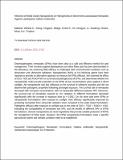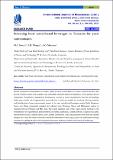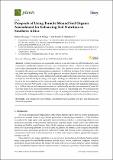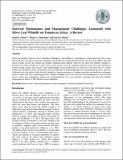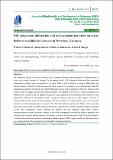Search
Now showing items 1-10 of 127
Potential of Indigenous Pesticidal Plants in the Control of Field and Post-Harvest Arthropod Pests in Bambara Groundnuts (Vigna subterranea (L.) Verdc.) in Africa: A Review
(Science Publishing Group, 2020-05-28)
Bambara groundnuts (Vigna subterranea (L.) Verdc.) is an important leguminous crop native in Africa and is mainly cultivated for its highly nutritious
grains. However, bambara groundnuts production is constrained by ...
Influence of Metal Oxides Nanoparticles on Pathogenicity of Steinernema carpocapsae Nematodes Against Lepidopteran Galleria mellonella
(American Scientific Publishers, 2020-03-01)
Entomopathogenic nematodes (EPNs) have been cited as a safe and effective method for pest management. Their virulence against lepidopterans and other foliar pest has been demonstrated in the laboratory, but achieving field ...
Screening local cereal-based beverages in Tanzania for yeast contaminants
(International Journal of Biosciences, 2021-02-26)
During spontaneous fermentation of cereals; yeasts ferment carbohydrates to produce alcohol and they also
provide vitamins, amino acids, peptides, and nucleotides needed by lactic acid bacteria as well as produce flavour ...
Effects of Selected Pesticidal Plants on Termites Affecting Maize Production in Arusha, Tanzania
(Scientific Research Publishing Inc., 2020-03-27)
Investigations under laboratory and field conditions were carried out with
purpose of understanding the effects of pesticides of Cupressus lusitanica,
Tephrosia vogelii, Eucalpytus dalrympleana, Lantana camara and ...
Prospects of Using Termite Mound Soil Organic Amendment for Enhancing Soil Nutrition in Southern Africa
(MDPI, 2020-05-20)
Termite mound soils are reportedly utilized as an alternative to NPK fertilizers by cash
constrained smallholder farmers in some parts of Southern Africa. However, there is limited
knowledge regarding their mineral ...
Influence of Tobacco Plant on Macronutrient Levels in Sandy Soils
(MDPI, 2020-03-19)
Tobacco (Nicotiana tabacum L.) is associated with great uptake of soil macronutrients.
Following the need to understand the macronutrients levels before and after tobacco cultivation,
research was conducted in loamy sand ...
Molecular identification of Salmonella Typhimurium from village chickens based on invA and spvC genes
(Veterinary World, 2020-04-23)
Aim: This study aimed to identify Salmonella enterica serovars by polymerase chain reaction (PCR) based on virulence
genes invasion A (inv A) and Salmonella plasmid virulence C (spvC).
Materials and Methods: DNA extraction ...
Survival Mechanisms and Management Challenges Associated with Silver Leaf Whitefly on Tomato in Africa: A Review
(Friends Science Publishers, 2022-04-30)
Silver leaf whitefly (Bemisia tabaci Gennadius) (Hemiptera: Aleyrodidae) is a polyphagous winged insect pest that causes high yield losses in tomatoes and other vegetable crops globally. To combat the infestation by the ...
Fall armyworm infestation and management practices on maize fields of smallholder farmers in Northern Tanzania
(Journal of Biodiversity and Environmental Sciences (JBES), 2019-10-30)
Fall armyworm (FAW) is native to America and is currently affecting maize production in different parts of Africa, and recently reported in Tanzania. In the present study, FAW infestation levels and their associated ...
Status of sucking insect pests in cashew growing locations of South and Central Zones, Tanzania
(International Journal of Biosciences, 2020-04-14)
Cashew (Anacardium occidentale L.) is an economically important cash crop for many rural households in Tanzania. However, its production is constrained by some insect pests and diseases. As a precondition for the development ...


